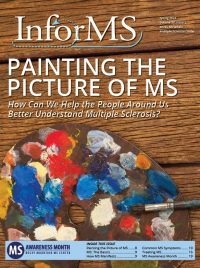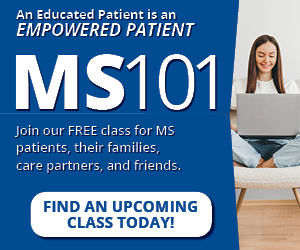
MS Awareness Month is an opportunity to draw attention to our MS community and help educate others about what it means to live with multiple sclerosis. Over the years that’s meant social media campaigns and emails, social events and fundraisers for the Rocky Mountain MS Center, and even articles here in InforMS Magazine.
In this issue of InforMS, we’ve decided to do something a little different. The coming pages feature an extended dive into MS itself – from the most basic facts about the disease, to an exploration of its complexities, to the most common symptoms, and finally to MS treatments.
And we’ve gone out into our community to speak to real people living with MS every day, who’ve shared with us the very different experiences they’ve each had navigating life with MS. While it would be impossible to represent all potential experiences with MS, we hope you’ll find these stories to be wide ranging, and an honest reflection of various MS experiences among people in our community.
For MS Patients and Those Close to Them:
If you or someone you love has been living with MS for a while, a lot of what you read in this issue might already be well known to you. Still, we hope these articles give you a succinct synopsis of MS all in one place, and a better understanding of how other peoples’ MS experiences may be similar and different from your own.
We also hope you’ll share this issue with friends, family members, neighbors, coworkers, or anyone else who may benefit from a deeper understanding of what living with MS is like.
For Friends, Extended Family, and Others:
If you’re just learning about MS for the first time or looking to learn more, what we’ve put together here will help you better understand the intricacies and complexities of this disease, which you’ll see is often complicated and frustrating.
Understanding exactly what MS is, how it manifests differently from person to person, how it’s treated today, and what it means for MS patients are important things to know, whether you’re completely new to MS or learning how to better support someone you know who’s living with MS.
MS: The Basics
Let’s start with the very basics. MS is a chronic, lifelong disease of the central nervous system that disrupts communication between the brain and other parts of the body. The severity of the disease and its symptoms vary widely from person to person. The cause of MS is unknown, and although there are treatments that can significantly alter the trajectory of the disease, at this time there is no known cure.
The central nervous system (CNS) is made up of the spine and brain. Nerve fibers in the CNS communicate with each other and many other organs via long cables called axons. The large axons of the CNS are wrapped in myelin, made of fat and protein, which helps the nerves conduct electrical impulses to and from the brain and spine. MS may cause injury in multiple locations in the CNS and the optic nerve. While the exact cause remains unknown, it appears the primary problem in MS is that the immune system mistakenly attacks this myelin coating around axons.
Areas where myelin has been damaged in this way are known as lesions, and these areas eventually fill in with scar tissue. The name multiple sclerosis means “many scars,” a reference to this scarring found in MS patients.
Damage from MS lesions disrupts the transmission of nerve impulses from the central nervous system to the rest of the body, which can cause a wide variety of symptoms, depending on exactly where those lesions occur.
Common symptoms include visual changes, muscle weakness, problems with balance, fatigue, numbness, and emotional and cognitive changes, but there are many others. Not all patients will experience all symptoms commonly associated with MS, and also won’t experience them with the same severity as others.
Because both the severity and location of MS lesions can vary widely from person to person, the symptoms that manifest for each individual are extremely unpredictable. This fact makes diagnosing MS challenging, because two patients will very rarely show exactly the same symptoms.
In many cases, an initial diagnosis of MS can take quite some time. Patients with concerning symptoms typically start out with a visit to their primary care physician. Depending on the symptoms they’re experiencing, their doctor may choose to treat those symptoms directly or explore other possible causes. If symptoms are severe or persistent over time, a doctor may refer a patient to a neurologist.
While a primary care physician can certainly suspect a patient has MS, definitive diagnosis will most likely come from a neurologist. This may involve a number of different diagnostic tools including a magnetic resonance imaging (MRI) scan to examine the brain, optic nerve or spine for MS lesions; a lumbar puncture (spinal tap) to examine spinal fluid for immune system abnormalities commonly seen in MS; and blood or other tests to rule out other conditions which may mimic MS. Presently there is no blood test for MS.
Once diagnosed, a patient can begin direct treatment for MS. The goal of MS treatment is to slow or stop progress of the disease and protect the nervous system from future exacerbations. At the Rocky Mountain MS Center, treatment goals are based on maximizing the lifelong brain health of each patient by using the most effective MS therapies and promoting a healthy overall lifestyle.
MS is most commonly diagnosed in young adults. About 80 percent of MS patients develop MS between the ages of 16 and 45. The National MS Society estimated in 2019 that around 915,000 people in the United States are living with MS. Of those, about 75 percent are women.
How MS Manifests
In the past, MS was commonly divided into four separate forms or “types” of the disease. Today we think of MS as one distinct disease, with different symptoms from person to person, but also changing manifestations over the course of the lifetime of a single patient. There is still debate as to how distinct or different these forms of MS are from each other, but it’s nonetheless useful to look at these four categories as a way to explain how MS manifests at different stages in different people.
Clinically Isolated Syndrome (CIS) refers to essentially the first outward, clinical signs of the disease, or the first relapse. Commonly this is between the ages of 20 to 45, but may be younger or older. Typical symptoms might be numbness, or visual disturbance such as optic neuritis. An individual after this first attack may already fulfill formal criteria for a diagnosis of MS based on the symptoms and lab tests, but if not, we simply call it a CIS. Over time, if a patient has more clinical symptoms, and/or new changes on MRI scans, they would then fulfill formal diagnostic criteria for MS. If a person never experiences another exacerbation, or their MS does not progress or get worse over time, this singular event is said to be CIS. Most patients however will eventually experience another exacerbation, in which case they fulfill criteria for a formal diagnosis of MS.
Relapsing-Remitting MS (RRMS) is diagnosed in someone when they have a second attack and/or new changes on MRIs over time. Typically, these would affect different parts of the CNS, and then an individual would formally fulfill criteria for MS. Up to 85% of people diagnosed with MS have relapses when diagnosed. For most with RRMS, relapses and new MRI changes are most common when they are younger, and risk of new relapses diminishes with age.
Secondary Progressive MS (SPMS) manifests about 10-15 years, on average, after a diagnosis of RRMS. Some (but not all) will begin to more overtly show signs of slowly worsening symptoms unrelated to, or in addition to, relapses. This may be manifested especially with greater walking and cognitive problems, and is called SPMS. Men, and especially those with very active relapses when first diagnosed, are at higher risk of developing SPMS. We now recognize that CIS, RRMS, and SPMS are all “relapsing” forms of MS. This is relevant to treatment (see below), as younger patients with active disease with recent relapses or new scan changes are more likely to benefit from present MS meds, regardless of whether this is called RRMS or SPMS.
Primary Progressive MS (PPMS) is diagnosed when someone has a steady progression of MS symptoms that is not preceded by relapses. Average age of onset is similar to those with SPMS, about 40-45. Followed long enough, a minority of those with PPMS could have a relapse.
Common MS Symptoms
So, what does MS look and feel like? That’s a surprisingly difficult question to answer.
As mentioned earlier, MS lesions can happen just about anywhere in the central nervous system. Symptoms can vary greatly, depending on where lesions occur and how severe the damage from each lesion is.
For example, lesions on the spinal cord could manifest as pain, numbness, or tingling in a patient’s arm. Lesions in certain parts of the brain could affect a person’s cognition, memory, or even their mood. Lesions on the optic nerve could obviously impact vision, but also might manifest as pain or optic neuritis.
Because MS lesions are so unpredictable, just about anything governed by the central nervous system can be affected and manifest as a symptom.
Further complicating things for those living with MS is the fact that so many common symptoms are what we refer to as “invisible” symptoms — things that aren’t always apparent to the outside world. One of the most often reported symptoms, for example, is fatigue — an overwhelming sense of tiredness and depletion of energy that can be a near constant experience for someone living with MS, yet the people around them may never know it.
It’s impossible to list all potential symptoms an MS patient may experience, but here we will list a few of the most commonly-experienced symptoms (in alphabetical order).
Bowel and Bladder Problems: This can include problems with constipation and/or urgency and incontinence, and also similar urinary problems. Because these symptoms frequently appear in the general population or along with other conditions, they’re not always recognized as MS symptoms.
Cognition: This refers to mental activities associated with thinking, learning, and memory. It’s estimated that roughly 45-75% of MS patients will experience cognitive issues. The degree and severity of cognitive issues can vary widely from person to person.
Dizziness and Vertigo: Bouts of dizziness during an exacerbation or on an ongoing basis can be extremely disruptive to MS patients. The symptoms can range from light headedness to sensations of rotational movement (vertigo) where individuals feel as if they or their surroundings are moving around and around.
Fatigue: Fatigue is probably the most common MS symptom and, along with pain, is one of the most frustrating for people to manage. It’s unpredictable and invisible, and is often misattributed, not to the MS disease process, but to depression, denial, disinterest, self-pity, disorganization, or even poor planning. As many as 90 percent of people with MS have fatigue – around half of them experience it every day. One third of people with MS describe it as their most troublesome symptom.
Mood Disorders & Depression: Depression is a troubling and common MS symptom. By some estimates, one in two people with MS will experience depression at some point, about three times the lifetime incidence in the general population. Mood disorders and emotional changes can also accompany MS, which may be reactions to the stress of living with a chronic disease or the result of neurological changes or lesions in particular areas of the brain.
Pain: The damage MS does in certain parts of the nervous system can cause sensory systems to become over-sensitive or overstimulated, resulting in MS patients experiencing pain that’s out of proportion with what’s actually going on in their body. In some cases, these sensory systems can register pain even when there are no external stimuli. This pain was formerly dismissed as nonexistent in MS, but we now know it’s fairly common and has been shown in some studies to occur in as many as 40 percent of people with MS.
Problems with Vision: Vision is one of our most valued senses and it can be very frightening to experience a sudden loss or change in vision. MS vision impairment can manifest as blurred or distorted vision, double vision, “holes” or spots in the visual field, or partial and even full vision loss. Patients who experience vision problems during an exacerbation usually recover fully, but repeated attacks can lead to permanent vision impairment.
Problems with Walking: Difficulties with walking are common MS symptoms and can sometimes be worsened when patients are experiencing other symptoms. People often report their legs feel weak. Muscle stiffness (spasticity), poor balance, and sensory disturbances such as numbness can contribute to walking problems. Fatigue can increase problems with balance, lower extremity weakness, stiffness, and numbness, which make it harder to walk safely and efficiently.
Spasticity and Stiffness: People with MS frequently experience “tightness” or stiffness in their muscles. Some people notice this stiffness more in the morning before their muscles warm up, or at night which can prevent them from getting the rest they need. Stiffness may be caused by a decrease in flexibility when activity levels decrease, or it may be due to spasticity, a neurological effect. MS-related spasticity occurs when there is an injury to the central nervous system. The injury results in abnormal messages being sent to the muscles which creates an increase in “tone” or muscle tightness.
These are a few of the most common symptoms experienced by MS patients and is by no means an exhaustive list. It’s important to note that treating MS symptoms has a direct effect on a patient’s quality of life, so it’s critical to ensure that they are working with their care provider to mitigate these and other symptoms, in addition to the direct treatment of MS itself (more on that in “Treating MS,” below).
People may experience some, all, or none of these symptoms and others, all to varying degrees of severity. Each patient’s experience is dependent on a number of factors, most importantly the location and severity of their MS lesions, the frequency of their relapses, or the speed of their MS progression.
Treating MS
Neurologists at the Rocky Mountain MS Center at University of Colorado are focused on maximizing lifelong brain health in MS patients. That involves a comprehensive model of treating MS that involves general overall health behaviors and promoting a healthy lifestyle through regular physical activity, balanced nutrition, and mental well-being. It’s in every patient’s best interest to make modifiable lifestyle choices that work for them, and promote overall brain health that can lead to protection against MS and disease progression.
It’s now well-known that co-morbidities — other medical conditions such as high blood pressure or diabetes — can delay diagnosis of MS and have a negative impact on a patient’s function and quality of life. Thus, maintaining an ideal body weight, not smoking, eating a well-balanced diet, getting excellent rest and exercising regularly are all very important.
Having said that, medical interventions are a critical part of treatment for most MS patients. When we talk about treating MS medically, we are generally talking about three things: treating symptoms, treating exacerbations or relapses, and treating the disease itself.
MS symptoms are most often treated directly – that is, we look at the symptoms themselves and see what can be done to alleviate the issue. For example, MS fatigue may be treated with medicines to help a patient sleep better, or through relaxation and exercise techniques aimed at increasing a person’s energy throughout the day. Pain might be treated with common pain medicines, or through physical therapy. Treatments for MS-related symptoms are as numerous as the symptoms themselves and are tailored to the needs of each individual patient.
MS relapses or exacerbations don’t always require treatment – if the symptoms are tolerable and not impacting a patient too much, they often get better on their own after days to months. When a patient is in the midst of a severe or prolonged exacerbation, a common way to treat them is with a course of IV or oral steroids. Steroids can help the body reduce inflammation and settle the immune system down, which can help shorten the length and reduce the severity of an exacerbation. Steroids, however, are only useful in treating these acute episodes, and don’t have any significant effect or long-term benefit on MS itself.
Treating MS directly is done with an expanding list of drugs we refer to as disease modifying therapies (DMTs). These DMTs all work in different ways, but generally they’re all aimed at settling down an over-active immune system that, in MS patients, is attacking their otherwise healthy nervous system. The first drug approved for the direct treatment of MS didn’t come out until 1993. Since then, new and more effective drugs have gradually been added to our arsenal. In recent years, both the number of drugs available and the effectiveness of these newer drugs has grown significantly.
MS DMTs can significantly slow the progress of the disease, or in some patients even stop it in its tracks entirely. While this is great news for the MS community, the fact remains that efforts to repair existing MS damage are still ongoing – right now, we don’t have effective ways to un-do the damage MS has already done in someone’s nervous system.
When and whether to start a DMT, how long to use DMT, which DMT to start and when to switch them, is a unique conversation with each patient. Medication and personal factors associated with making a choice include: how the drug is delivered (injection, oral or IV infusion), side effects, long-term risks, effectiveness, pregnancy, insurance limitations, patients’ and doctors’ views of the DMTs and others. Two common approaches are used. The older idea is to first use moderately effective, but better-known DMTs with perhaps lower risk profiles, and only escalate to using more highly effective therapies if these are not tolerated or the patient has more new disease activity. But many patients do, indeed, fail or not tolerate these therapies.
The time of highest risk from MS is when people are younger with active disease, and younger patients tolerate DMTs better than older individuals. Thus, the Neurologists at the Rocky Mountain MS Center at University of Colorado feel that for the majority of individuals with MS, use of more highly effective therapies early in the disease course will give the patient the greatest opportunity to achieve our main goal: life-long brain health.
The neurology team at the Rocky Mountain MS Center generally categorize today’s many DMTs as follows:
First-Line Treatments: Highly Effective
Ocrelizumab (Ocrevus), ofatumumab (Kesimpta) and rituximab (Rituxan): These drugs are either infusions usually given once every six months (ocrelizumab and rituximab), or self-injectable monthly medications administered at home (ofatumumab). Often referred to by doctors as “anti-CD20s,” they work by selectively depleting CD20 B cells in the immune system. There may be infusion or injection reactions, and the main long-term issues are increased risks of infections.
Natalizumab (Tysabri) in JCV negative patients: This is a once-monthly infusion that blocks the ability of B and T cells to cross the blood-brain barrier. Patients must test negative and continue monitoring for prior exposure to the JC virus, a common infection that usually doesn’t harm people on its own, but in rare cases can lead to progressive multifocal leukoencephalopathy (PML). PML is a destructive and potentially fatal brain infection. This risk is not an issue if the patient has not been exposed to the JC virus.
Second-Line Treatments: Moderately Effective
Fingolimod (Gilenya and generics), siponimod (Mayzent), ozanimod (Zeposia), and ponesimod (Ponvory): These are once-daily oral medications that work trapping lymphocytes in lymph nodes. Generally well-tolerated but with low risk of PML and generally increased risk of routine infections like upper respiratory infections.
Dimethyl fumarate (Tecfidera), monomethyl fumarate (Vumerity): These are twice-daily oral medications that differ in dosage based on the exact formulation of the product. They work by inhibiting inflammation caused by astrocytes. They can be associated with significant short-term, transient gastrointestinal side effects and flushing, but these diminish over time and with taking the medication with food.
Third-Line Treatments: Modestly Effective
Teriflunomide (Aubagio): This is a once-daily oral medication that works by inhibiting the growth of lymphocytes, a type of white blood cell. Need to monitor liver tests and there can be modest hair thinning.
Glatiramer acetate (Copaxone, Glatopa, generic GA): These are self-administered injections given at home, with frequency depending on the specific formulation of the product (usually three times weekly). They work by introducing a regulatory B cell to fight MS, and are also very safe and unlikely to cause many side effects.
Beta interferons (Avonex, Rebif, Betaseron, and others): These drugs are self-administered injections that work by decreasing the ability of lymphocytes to enter the brain. They are associated with achiness, fatigue and other injection side effects that generally diminish with time.
Fourth-Line Treatments: Highly effective but perhaps with enhanced risks
Natalizumab in JCV positive patients: Although listed above as a “First-Line” treatment, natalizumab moves to the bottom of the list for patients who’ve tested positive for the JC virus, due to the possibility of triggering PML.
Alemtuzumab (Lemtrada): This drug is administered with five days of infusions in the first year, followed by three days in year two. It works by killing certain immune system cells, which has shown to be significantly effective in MS, but has a relatively severe side effect profile which greatly limits its use.
Cladribine (Mavenclad): This is an oral chemotherapy that inhibits inflammation from lymphocytes and temporarily reduces T and B cells in the immune system. It has shown to be significantly effective in MS, but has been associated with possible cancer risks.
As with anything else, all patients should talk with their MS care team to decide which of these treatments is the right choice for them when they start a DMT, and over time with any changes.
Conclusion
MS Awareness Month is not just an opportunity to let people know members of their community are living with MS – it’s a chance for us to help them truly understand what living with MS means. To do that, it’s important to understand how different MS may look from one person to the next. This isn’t a disease that fits neatly into a single definition or a telltale list of symptoms. We know that it’s multi-faceted and complex, and can be both obvious and invisible to the people around us.
We hope you’ve found this synopsis of multiple sclerosis helpful, and invite you to explore our website for more information. Everything you’ve read here will be available at MSCenter.org/informs, where you can easily email or post links to these articles for others you think may benefit.






